Braised Pork Shoulder in Asturian Cidra
This braised pork shoulder in Asturian Cider recipe will literally melt in your mouth! Infused with the rich flavors of cider, fennel, and other aromatic herbs. Braised pork shoulder in Asturian Sidra is a rustic Spanish cider pork recipe that pays homage to northern Spain’s culinary heritage, where pork and apples have long been a natural pairing.
The result? Tender, aromatic pork cheeks bathed in a sauce that’s tangy, savory, and slightly sweet.
Use authentic Asturian cider (sidra) to give this dish a depth of flavor you won’t find in ordinary braises. With rich caramelized onions, fennel, and seasonal apples, it transforms into a hearty yet elegant Asturian pork stew, perfect for family dinners or festive gatherings.
Serve it with creamy mashed potatoes or crusty bread, and you’ll have a showstopping dish that brings the flavors of Spain right to your table.
This post may contain affiliate links.
Serving:
Main for 6
Ready in:
2.5 hours
Skill level:
Easy
Serve with:
mashed potato
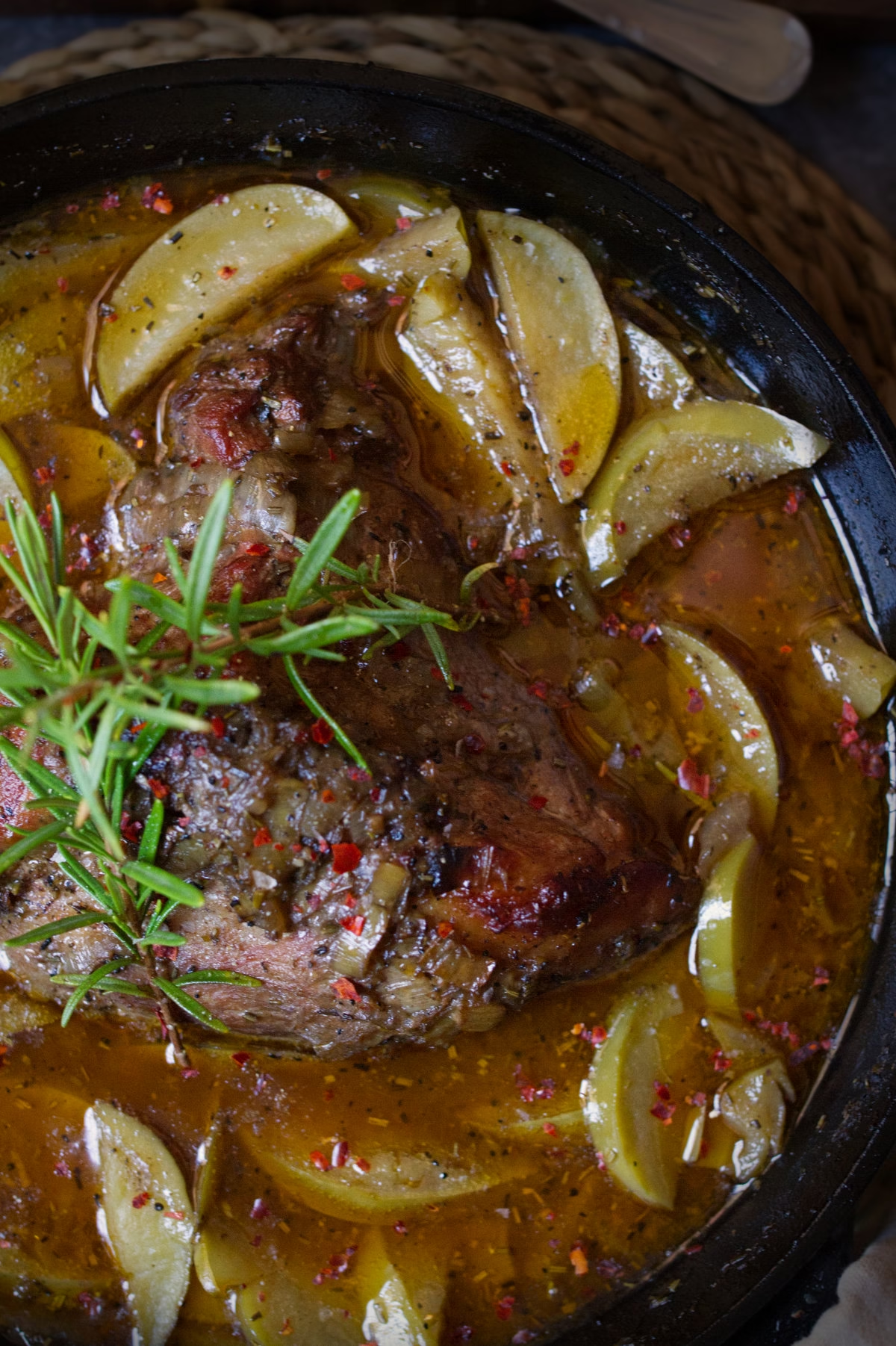
How to Make Braised Pork Shoulder in Asturian Cider
Ingredients
- 42oz. (1200g) pork shoulder
- Extra Virgin Olive Oil
- 1 white onions, thinly sliced
- 1 leek, thinly sliced into rounds
- 6 garlic cloves, roughly chopped
- ¼ tsp pepper flakes (optional)
- A few sprigs of fresh rosemary
- 1 tsp Dried Rosemary (organic)
- 1 tsp fennel seeds, ground
- 2 star anise, ground
- 2 small dried Guindilla Peppers (optional)
- 6 cloves
- 2 bay leaves, dried
- 2 cups unfiltered apple cider (we used Asturian sidra)
- 2 Tbsp apple cider vinegar
- 2 cups Organic Low Sodium Chicken Broth / stock
- 2 apples, cored and quartered
- Salt and Pepper to taste
Note: If you can’t source fresh leek, use fennel bulbs for a comparable texture.
Equipment
- Large Cast Iron Dutch Oven with Lid
- Wooden cutting board
- Chef knife
- Cooking Tongs
- Premium Ceramic Garlic Grater
- Mortar and Pestle
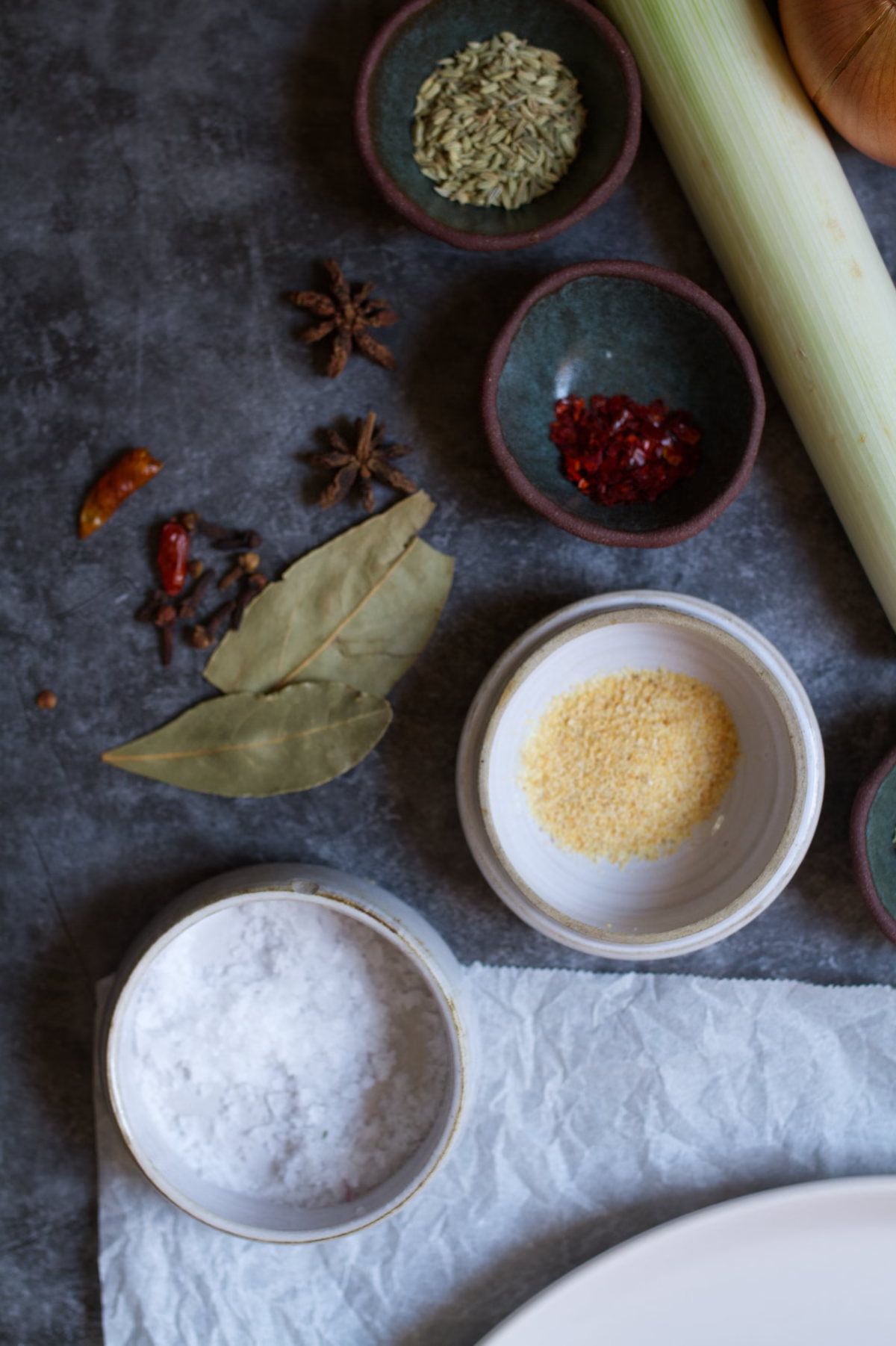
Instructions
Step 1 – Season and sear the pork
- Preheat oven to 180°C / 350°F.
- Season your pork on all sides with plenty of salt and pepper, some garlic powder, and a pinch of dried rosemary.
- Add a splash of oil to a large skillet on high heat and brown the pork on all sides. Around 4-5 minutes per side. Once done, transfer the pork to a plate.
Step 2 – Cook the veggies
- Reduce the heat to medium.
- Add the sliced onion and leek to the same pan and cook until softened and lightly caramelized, this will take about 10 minutes.
- Once the veggies are done, add ¼ cup of the chicken stock to deglaze the bottom of the pan.
Step 3 – Add the aromatics and Sidra/Cider
- Add the garlic and cook for around a minute or until fragrant.
- In a mortar and pestle, crush the fennel seeds, star anise, cloves, and dried chili pepper into a coarse powder.
- Add the ground powder, apple cider, and apple cider vinegar. Season to taste with some salt and pepper.
- Increase the heat to high and bring to a boil for 4-5 minutes (this will burn off any alcohol content in the cider/sidra.
- Add around 1 cup of chicken stock and add the bay leaves.
Step 4 – Braise pork
- Return the seared pork to the pan and season.
- Top up with some more cider or chicken stock. The liquid should cover most of the meat.
- Cover and braise in the oven for 2 hours at 180°C / 350°F.
- Every 30 minutes, spoon some of the liquid over the top.
- At the last half hour mark, add the sliced apples around the pork.
- Keep an eye on moisture levels throughout cooking, and add more stock, or cider if required.
Step 5 – Check doneness and rest pork
- Once cooked, the pork should be fork-tender and easily falls aprt. Remove from the heat and leave uncovered to rest for at least 10 minutes before serving.
- Garnish with a few sprigs of fresh rosemary.
Serving Suggestions:
Serve on a bed of creamy mashed potatoes or alongside plenty of fresh bread to soak up the delicious sauce.
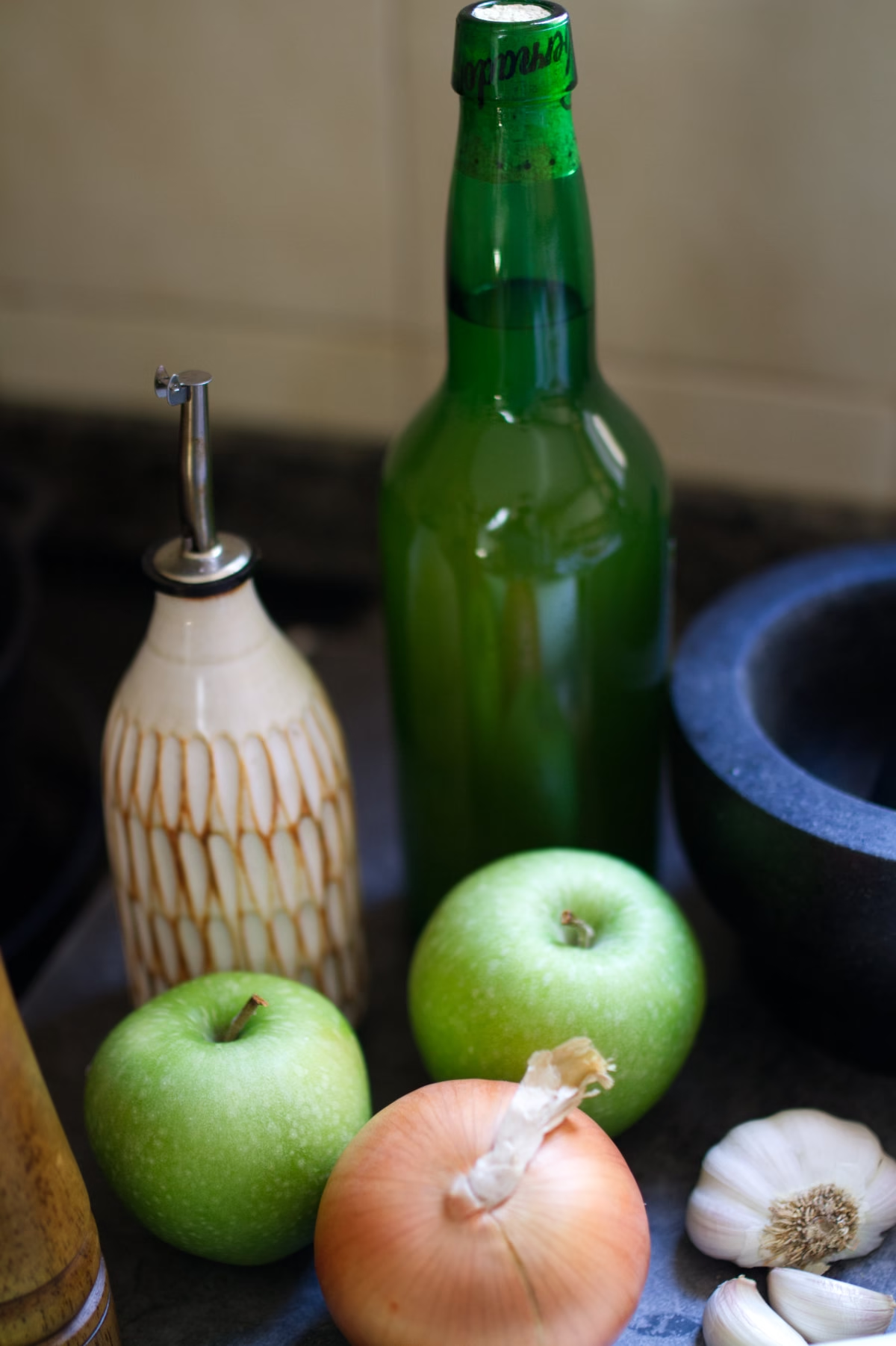
Asturian Cider – A Taste of Tradition
The Asturias region in northern Spain is full of culinary treasures, but one of the most iconic is Asturian cider (sidra de Asturias). It’s more than just a drink here—it’s part of daily life, celebrated in local culture and cuisine, and even protected with its own PDO (Protected Designation of Origin) status.
What is Asrurian Sidra?
Made from freshly pressed apples, Asturian cider is fermented the traditional way, creating a refreshing, slightly tangy drink. It’s not your typical fizzy, sweet cider—it’s usually still (non-carbonated), cloudy, and slightly tart, with an alcohol content of around 5%.
What makes it special is the way it’s made and enjoyed:
- Production: It’s crafted using a natural fermentation process with local Asturian apples. No sugar or carbonation is added.
- Culture: Sidra is deeply tied to Asturian identity and gastronomy. It even has a Protected Designation of Origin (PDO), meaning only cider made in Asturias with approved apples can carry the name Sidra de Asturias.
- Tradition: Drinking it is a ritual. In local sidrerías (cider houses), it’s “thrown” (escanciado)—poured from high above into a glass held low, so the cider splashes and aerates, releasing its aromas. Only a small amount is poured at a time, and it’s meant to be drunk in one or two sips.
Because of its bright acidity and natural apple character, Asturian sidra is also widely used in cooking—most famously in chorizo a la sidra, where chorizo is simmered in cider to absorb all that tangy, fruity flavor.

Why Cider Works So Well in Cooking
If you visit a local sidrería (cider bar), you’ll see a unique ritual known as “throwing the cider”: it’s poured from high above the server’s head into a glass held at the waist. Only a small splash—about a quarter of the glass—is served each time. This aerates the cider, releasing its fresh apple aromas without the need for carbonation.
That same quality makes Asturian cider perfect for cooking. Just a quick 10–15 minute simmer is enough to let the cider work its magic, infusing dishes like chorizo a la sidra with a smoky, tangy depth of flavor.
More Asturian Sidra Recipes:
Is Cider the Same as Cider Vinegar?
Not at all. Cider vinegar is much sharper and lacks the fruity, delicate notes of fresh cider—so it won’t work as a substitute here. The best choice is non-carbonated cider, but if you can’t find it, a regular (less sweet) cider will still give you a great result.
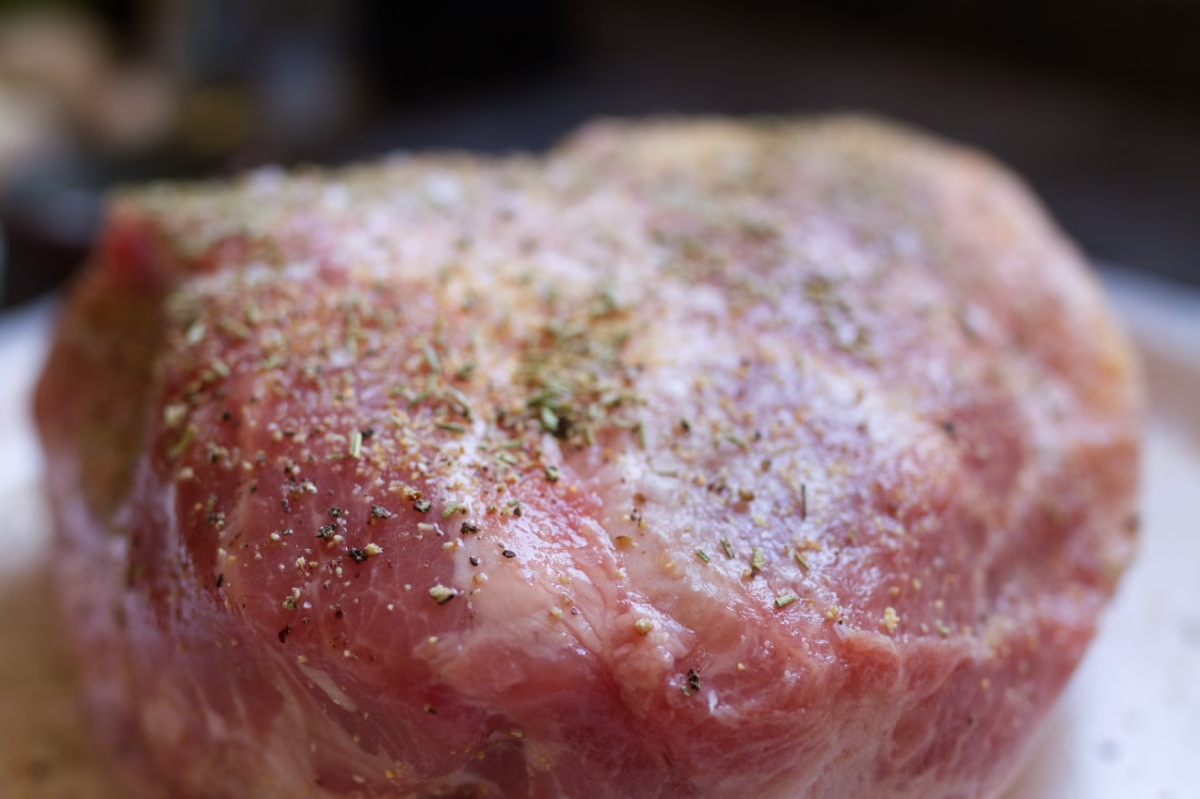
What is the best cut of pork to use when slow cooking?
1. Pork Shoulder (Boston Butt or Picnic Roast) – Best All-Around
- Why it’s great:
Pork shoulder has lots of marbling and connective tissue, which melts down into a rich, succulent texture during slow cooking.
It’s perfect for shredding or pulling. - Ideal for:
Pulled pork, carnitas, stews, braises. - Cooking tips:
- Cook low and slow (around 90–120°C / 200–250°F) for several hours.
- Leave the fat cap on for added flavor and moisture.
2. Pork Belly – Ultra Rich and Tender
- Why it’s great:
Very high in fat, pork belly becomes incredibly tender and melt-in-your-mouth when braised or slow roasted. - Ideal for:
Asian braises, crispy pork belly, rich stews. - Cooking tips:
- Render the fat slowly to avoid greasiness.
- Consider finishing under a broiler for a crispy top.
3. Pork Ribs (Spare Ribs or Baby Back Ribs)
- Why it’s great:
The connective tissue around the bones breaks down beautifully, giving tender meat with deep flavor. - Ideal for:
BBQ ribs, braised ribs, slow cooker rib stews. - Cooking tips:
- Keep them covered or wrapped in foil to prevent drying out.
- A final glaze or sauce added at the end boosts flavor.
4. Pork Cheeks (Carrillada) – For Gourmet Braises
- Why it’s great:
Naturally high in collagen, pork cheeks become silky and tender when slow cooked. - Ideal for:
Spanish dishes like Carrillada Ibérica, rich stews, wine-braised recipes. - Cooking tips:
- Best cooked submerged in liquid like wine or stock.
- Simmer gently for 2.5–3 hours for perfect tenderness.
5. Pork Shank (Hock)
- Why it’s great:
Full of bone marrow and connective tissue, giving deep flavor and rich stock. - Ideal for:
Soups, German-style Eisbein, or Italian Osso Buco-style dishes. - Cooking tips:
- Brown first to build flavor.
- Cook in a broth for both tender meat and a flavorful base.
Cuts to Avoid for Slow Cooking
- Pork Tenderloin or Loin – Too lean; dries out quickly.
- Pork Chops – Better for quick cooking methods like grilling or pan-frying.
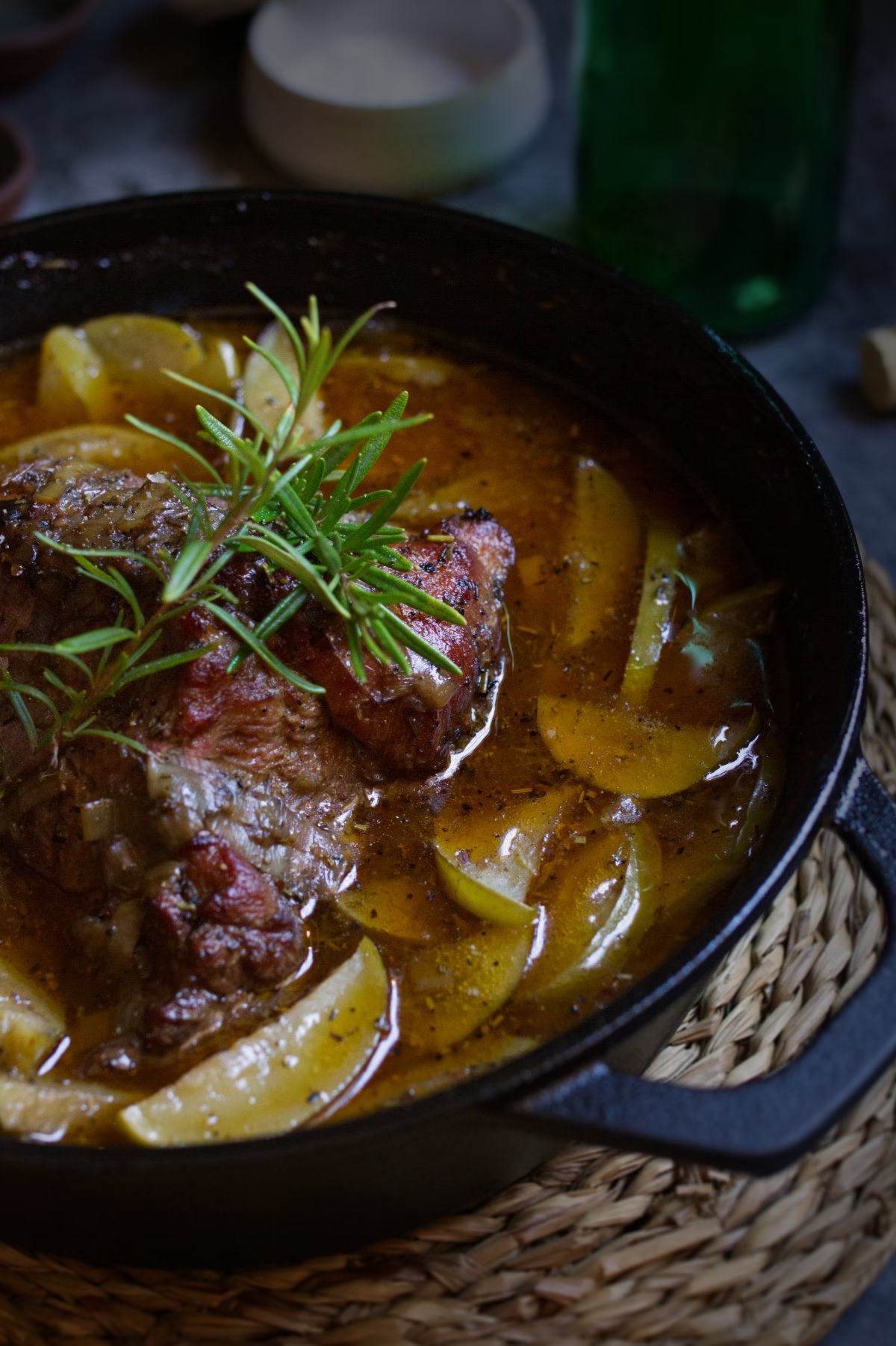
Best Herbs for Cooking Pork with Cider
When braising pork with Asturian sidra (cider), herbs are key to building depth and balance in the dish. Sure, you could make this dish with just the pork, apple, sidra, and some salt and pepper, but adding a few spices and herbs really helps layer flavor and bring everything together.
Here’s what we used:
Rosemary
Rosemary is the standout—it brings a fragrant, pine-like aroma that cuts through the richness of pork shoulder. Fresh sprigs infuse the cider with a light, herbal freshness, while dried rosemary adds a more concentrated earthy note, making the pork taste even more savory.
Fennel Seeds
Fennel seeds are another natural partner for pork. Their sweet, slightly licorice-like flavor complements the apple notes in the cider and helps soften the tangy edge. Simmered slowly, fennel adds a roundness that ties the meat and fruit together beautifully.
Star Anise and Cloves
To layer even more complexity, spices like star anise and cloves provide subtle warmth and a gentle sweetness, almost like a nod to mulled cider. These flavors never dominate but create a rich background that enhances the dish’s rustic character.
Bay Leaves
Meanwhile, bay leaves add a mild bitterness that balances out the sweetness of the apples and cider, ensuring the flavors don’t become too heavy.
This careful blend of herbs and spices doesn’t just season the pork—it transforms it. By layering flavors, they highlight the natural savoriness of the meat and the bright acidity of the cider, creating a dish that’s both hearty and beautifully balanced.
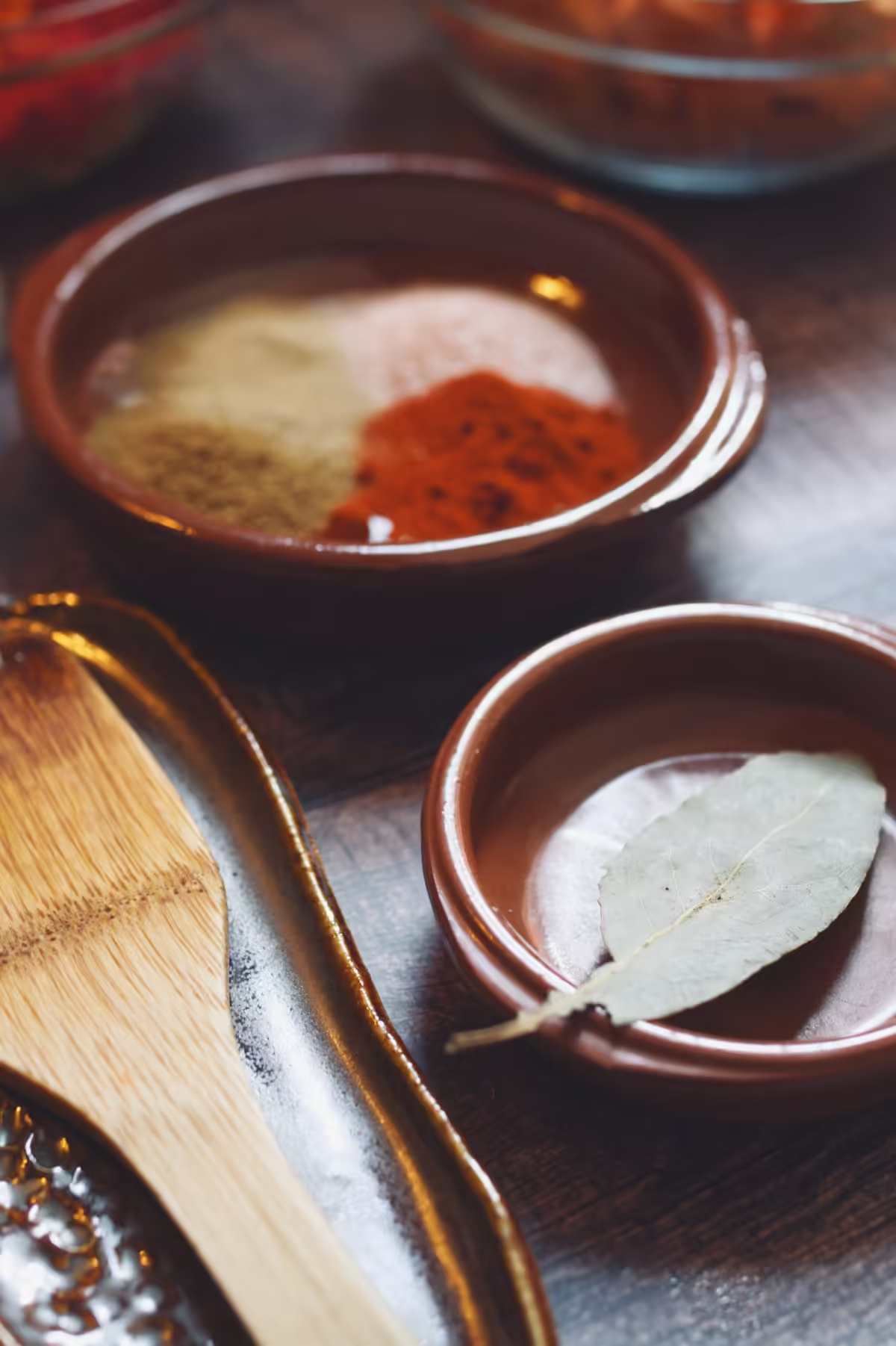
Nutrition Facts (per serving, 6 servings)
- Calories: 563 kcal (28% DV)
- Protein: 37 g (74% DV)
- Fat: 36.7 g (47% DV)
- Carbohydrates: 19.3 g (7% DV)
- Fiber: 2.5 g (9% DV)
FAQs: Braised Pork Shoulder in Asturian Sidra
Q1: Can I use another type of cider if I can’t find Asturian sidra?
Yes. If Asturian sidra isn’t available, choose a dry, non-carbonated apple cider. If you can only find sparkling cider, try to pick a less-sweet version, as it will still balance well with the pork and herbs.
Q2: What cut of pork is best for this recipe?
Pork shoulder is the ideal cut thanks to its marbling and connective tissue, which break down during braising to create tender, juicy meat. Other cuts like pork cheeks (carrillada) or pork shank also work well if you prefer a different texture.
Q3: Can I make this recipe ahead of time?
Absolutely. Braised pork shoulder often tastes even better the next day, once the flavors have had more time to meld. Simply reheat gently on the stove or in the oven before serving.
Q4: What can I serve with braised pork shoulder in cider?
Creamy mashed potatoes, roasted root vegetables, or rustic crusty bread are perfect sides to soak up the rich sauce. For a lighter option, serve with a crisp green salad.
Q5: Is cider vinegar the same as cider?
No. Cider vinegar is sharper and more acidic, and it won’t work as a substitute in this recipe. Always use cider, preferably non-carbonated, for the best results.
Q6: Can I freeze leftovers?
Yes, this dish freezes well. Store cooled portions in airtight containers and freeze for up to 3 months. Defrost in the fridge overnight and reheat gently before serving.
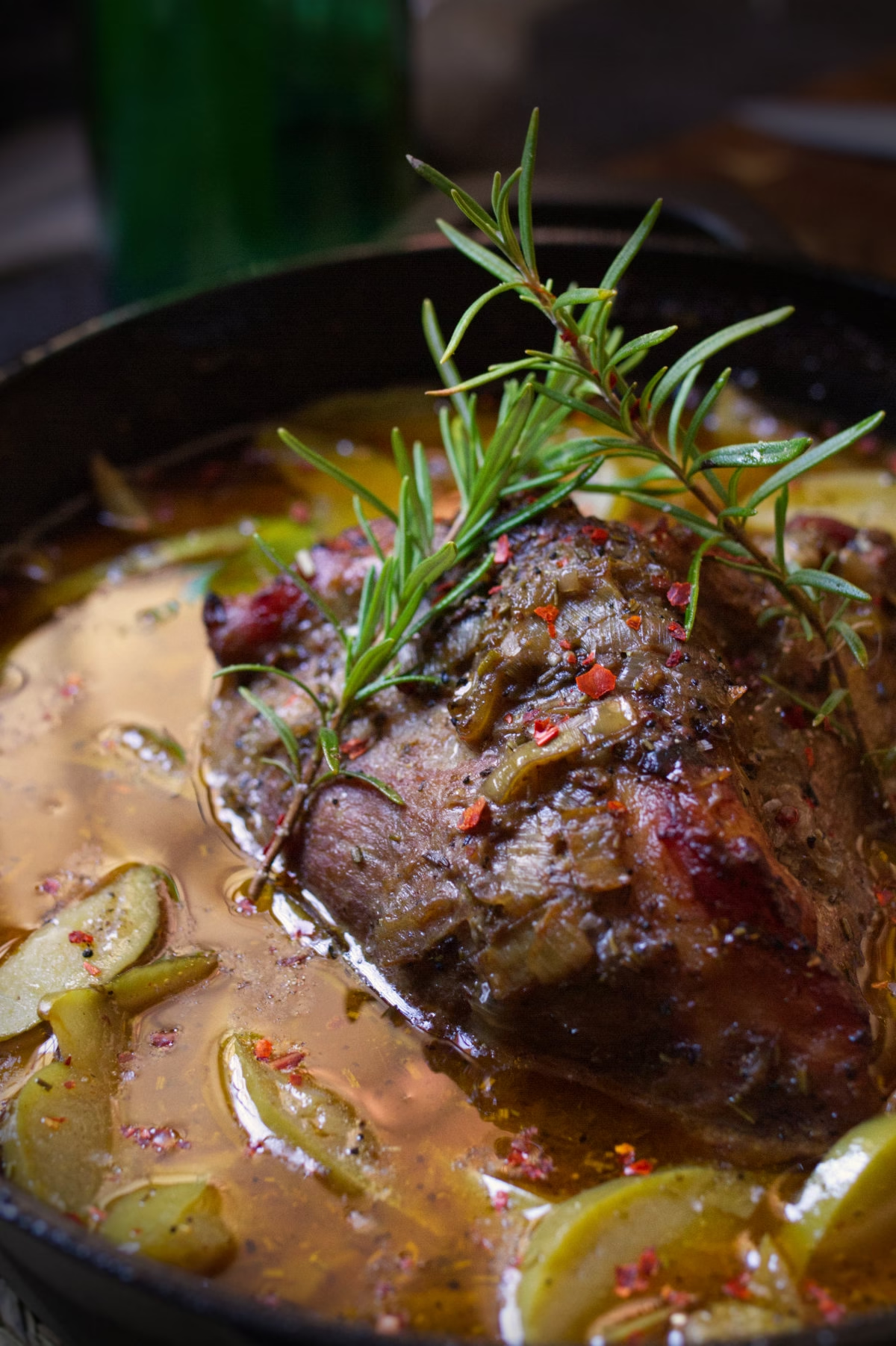
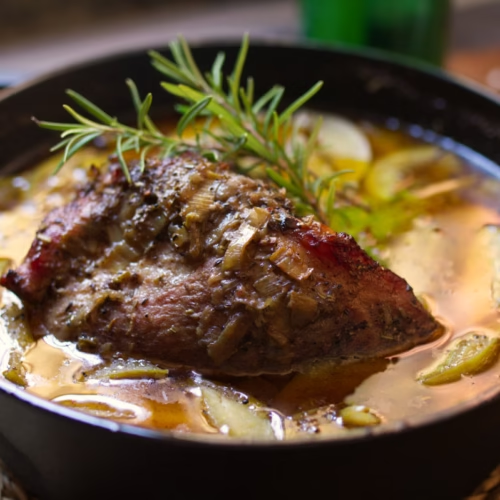
Brasied Pork Shoulder in Asturian Cider
Equipment
- Large Cast Iron Dutch Oven with Lid
- Wooden cutting board
- Chef knife
- Cooking Tongs
- Premium Ceramic Garlic Grater
- Mortar and pestle
Ingredients
- 42 oz. 1200g pork shoulder
- Extra Virgin Olive Oil
- 1 white onions thinly sliced
- 1 leek thinly sliced into rounds
- 6 garlic cloves roughly chopped
- ¼ tsp pepper flakes optional
- A few sprigs of fresh rosemary
- 1 tsp Dried Rosemary organic
- 1 tsp fennel seeds ground
- 2 star anise ground
- 2 small dried Guindilla Peppers optional
- 6 cloves
- 2 bay leaves dried
- 2 cups unfiltered apple cider we used Asturian sidra
- 2 Tbsp apple cider vinegar
- 2 cups Organic Low Sodium Chicken Broth / stock
- 2 apples cored and quartered
- Salt and Pepper to taste
Instructions
Step 1 - Season and sear the pork
- Preheat oven to 180°C / 350°F.
- Season your pork on all sides with plenty of salt and pepper, some garlic powder, and a pinch of dried rosemary.42 oz. 1200g pork shoulder, Salt and Pepper to taste, 1 tsp Dried Rosemary
- Add a splash of oil to a large skillet on high heat and brown the pork on all sides. Around 4-5 minutes per side. Once done, transfer the pork to a plate.Extra Virgin Olive Oil
Step 2 - Cook the veggies
- Reduce the heat to medium.
- Add the sliced onion and leek to the same pan and cook until softened and lightly caramelized, this will take about 10 minutes.1 white onions, 1 leek
- Once the veggies are done, add ¼ cup of the chicken stock to deglaze the bottom of the pan.2 cups Organic Low Sodium Chicken Broth / stock
Step 3 - Add the aromatics and Sidra/Cider
- Add the garlic and cook for around a minute or until fragrant.6 garlic cloves
- In a mortar and pestle, crush the fennel seeds, star anise, cloves, and dried chili pepper into a coarse powder.¼ tsp pepper flakes, 1 tsp fennel seeds, 2 star anise, 2 small dried Guindilla Peppers, 6 cloves
- Add the ground powder, apple cider, and apple cider vinegar. Season to taste with some salt and pepper.2 cups unfiltered apple cider, 2 Tbsp apple cider vinegar
- Increase the heat to high and bring to a boil for 4-5 minutes (this will burn off any alcohol content in the cider/sidra.
- Add around 1 cup of chicken stock and add the bay leaves.2 bay leaves
Step 4 - Braise pork
- Return the seared pork to the pan and season.
- Top up with some more cider or chicken stock. The liquid should cover most of the meat.
- Cover and braise in the oven for 2 hours at 180°C / 350°F.
- Every 30 minutes, spoon some of the liquid over the top.
- At the last half hour mark, add the sliced apples around the pork.2 apples
- Keep an eye on moisture levels throughout cooking, and add more stock, or cider if required.
Step 5 - Check doneness and rest pork
- Once cooked, the pork should be fork-tender and easily falls aprt. Remove from the heat and leave uncovered to rest for at least 10 minutes before serving.
- Garnish with a few sprigs of fresh rosemary.A few sprigs of fresh rosemary
Video
Notes
Serving Suggestions:
Serve on a bed of creamy mashed potatoes or alongside plenty of fresh bread to soak up the delicious sauce.Love this recipe?
Leave us a comment and tell us your favorite Spanish recipe!
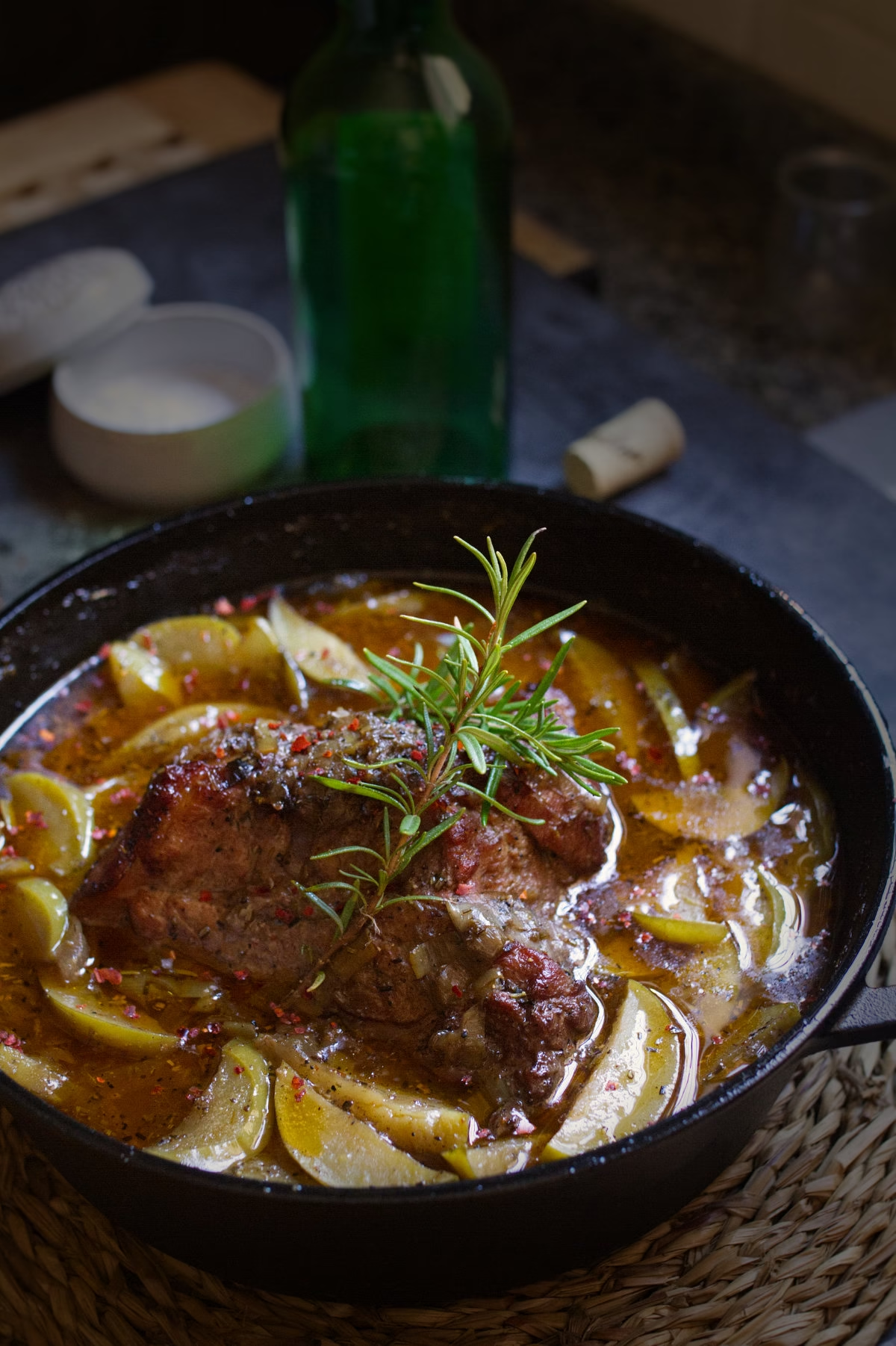

0 Comments